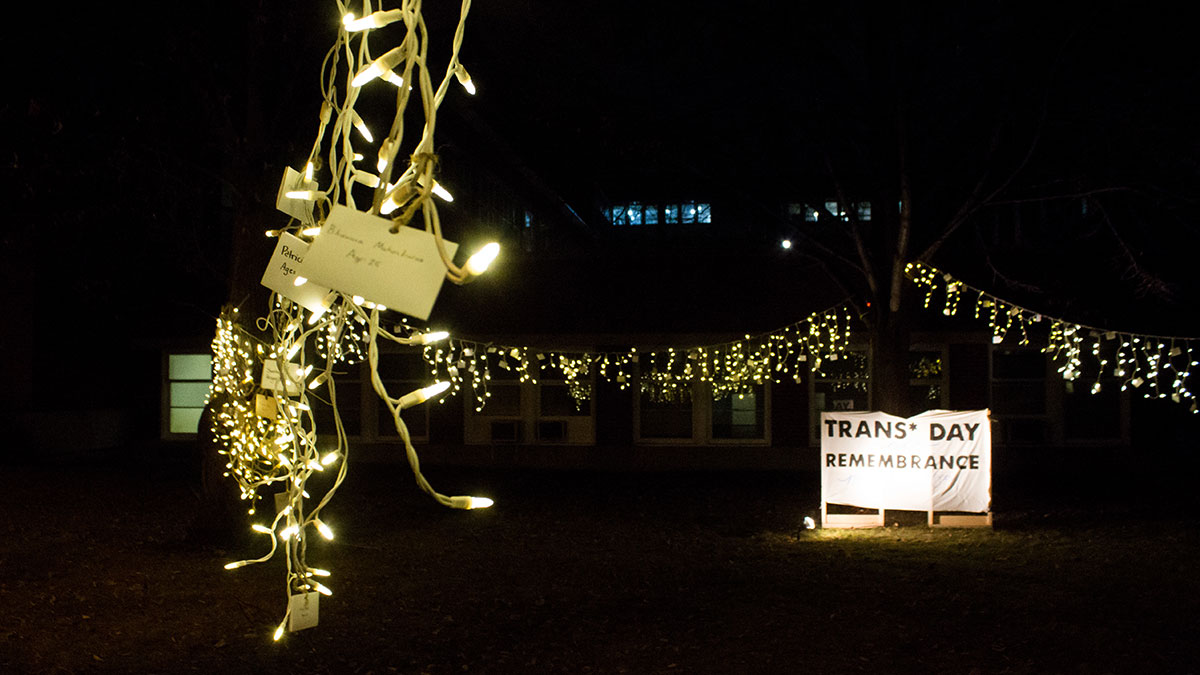Memorial marks Trangender Day of Remembrance
 Christina Varvis
Christina VarvisAfter being dropped off at a park in Philadelphia on Oct. 6, 22-year-old Keisha Jenkins was beaten and shot to death. Jenkins, a Temple University student, was a transgender woman, and the 21st trans person to be murdered in the U.S. this year.
The names of 270 trans people who were killed last year are part of an art installation south of the Dentinstry-Pharmacy building to honour Trans* Day of Remembrance (TDoR) and Transgender Awareness Week, which was founded in 1999. TDoR has been held annually every Nov. 20 to commemorate those who died as a result of anti-trans violence in the last year.
Co-organized by The Landing, the Institute for Sexual Minorities Studies and Services (ISMISS), Feminists at the U of A, and OUTreach; the week-long art installation will be lit up nightly until the Friday, Nov. 20. Friday’s TDoR events will commence with a meeting at 122 Education South, a walk over to the installation, and a return to the Education building for group reflections.
Shayne Golosky-Johnston, a volunteer with The Landing, said that when they began compiling a list of names, they had 250, and the final list was 270.
“Being trans, you don’t have a choice whether you’re an activist or not,” Golosky-Johnston said. “Your life is your cause.”
Rafiki Dave, an assistant program coordinator at The Landing, said that just because the names on the art installation are those of trans individuals who were murdered in the past year, it doesn’t mean that is the only violence towards transgender individuals.
“Microaggressions and hate speech are all forms of violence,” Dave said. “In our city and in every city, there is some form of violence towards trans individuals and queer individuals.”
Dave also said that although names on the memorial are of those who were murdered, suicides in the trans population can also be linked to this type of discrimination.
Daniella Marchand, Office Coordinator at The Landing, said that TDoR is not limited to the commemoration of individuals.
“The asterisk is included to help anyone who finds themselves on that spectrum to identify with it,” Marchand said. “It’s a very personal thing, and asterisk just includes any individual who identifies with it.”
Some of the entries on the memorial indicate no name or age, and some have only one or two pieces of information about the person they are commemorating. Marchand said many of the individuals on the memorial were not commemorated initially with respect given to their chosen name or pronouns, and that the TDoR memorial aims to right this wrong.
“People are real and have learned experiences,” Dave said. “A lot of times when people don’t understand somebody, they alienate them. But we’re all people, and we all have a story.”
Dave said the sense of community created by public events such as the TDoR as essential in creating a campus where trans individuals feel safe and welcome. The Landing wants to make it known that it is the responsibility of the whole campus community to reduce violence against trans individuals. Even if it is as simple as deleting transphobic language from your vocabulary and calling it out in other people, everything helps mitigate trans violence.
“This campus is huge, there are thousands of people here,” Dave said. “That sense of belonging is important, so when people experience transphobic slurs or other forms of violence, they have a community to come to.”




